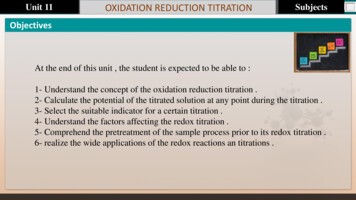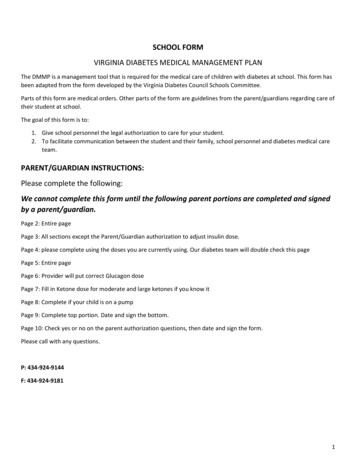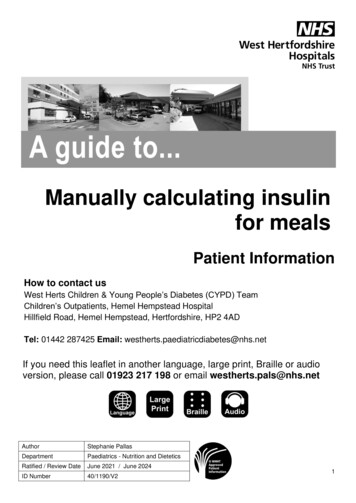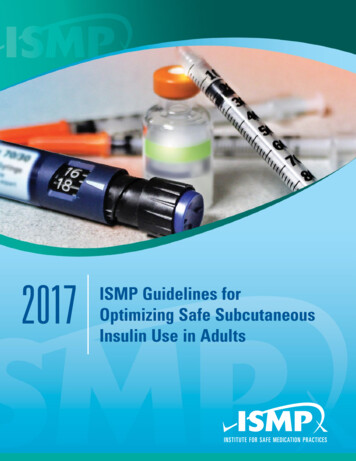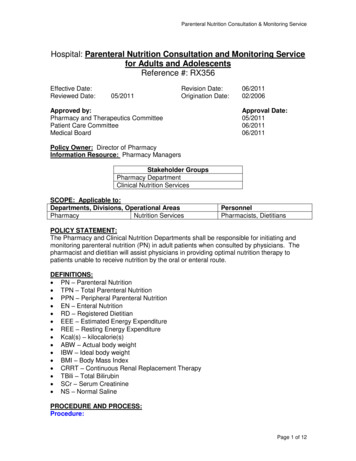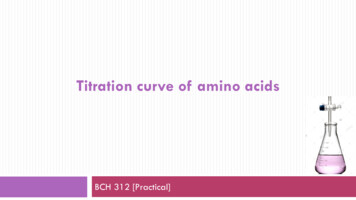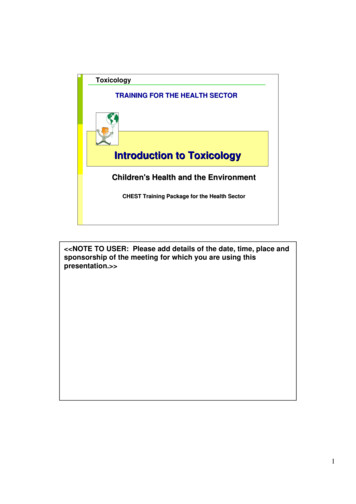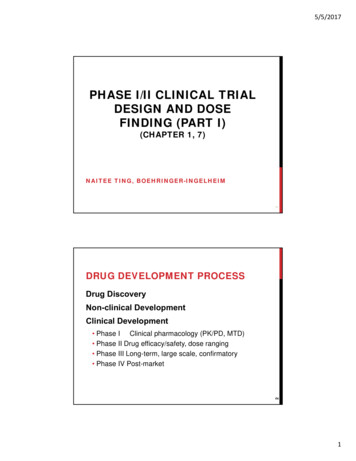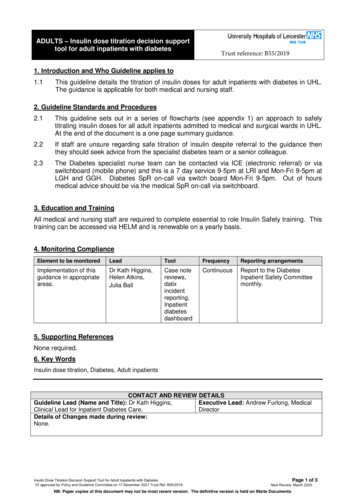
Transcription
ADULTS – Insulin dose titration decision supporttool for adult inpatients with diabetesTrust reference: B55/20191. Introduction and Who Guideline applies to1.1This guideline details the titration of insulin doses for adult inpatients with diabetes in UHL.The guidance is applicable for both medical and nursing staff.2. Guideline Standards and Procedures2.1This guideline sets out in a series of flowcharts (see appendix 1) an approach to safelytitrating insulin doses for all adult inpatients admitted to medical and surgical wards in UHL.At the end of the document is a one page summary guidance.2.2If staff are unsure regarding safe titration of insulin despite referral to the guidance thenthey should seek advice from the specialist diabetes team or a senior colleague.2.3The Diabetes specialist nurse team can be contacted via ICE (electronic referral) or viaswitchboard (mobile phone) and this is a 7 day service 9-5pm at LRI and Mon-Fri 9-5pm atLGH and GGH. Diabetes SpR on-call via switch board Mon-Fri 9-5pm. Out of hoursmedical advice should be via the medical SpR on-call via switchboard.3. Education and TrainingAll medical and nursing staff are required to complete essential to role Insulin Safety training. Thistraining can be accessed via HELM and is renewable on a yearly basis.4. Monitoring ComplianceElement to be monitoredLeadToolFrequencyReporting arrangementsImplementation of thisguidance in appropriateareas.Dr Kath Higgins,Helen Atkins,Julia BallCase esdashboardContinuousReport to the DiabetesInpatient Safety Committeemonthly.5. Supporting ReferencesNone required.6. Key WordsInsulin dose titration, Diabetes, Adult inpatientsCONTACT AND REVIEW DETAILSGuideline Lead (Name and Title): Dr Kath Higgins,Executive Lead: Andrew Furlong, MedicalClinical Lead for Inpatient Diabetes Care.DirectorDetails of Changes made during review:None.Insulin Dose Titration Decision Support Tool for Adult Inpatients with DiabetesV2 approved by Policy and Guideline Committee on 17 December 2021 Trust Ref: B55/2019Page 1 of 3Next Review: March 2025NB: Paper copies of this document may not be most recent version. The definitive version is held on INsite Documents
DRAFTADULT INPATIENTUniversity Hospitals of LeicesterNHS TrustInsulin Dose Titration Decision Support ToolThis Insulin Dose Titration Decision Support Tool is not applicable to patients on continuoussubcutaneous insulin pump treament.Basal Bolus Insulin Regime Standard CBG targetis 6-10mmols (4-12mmolsacceptable) Conservative CBG targetFrail older patients7.8-10mmol/l, moderate/severe frailty and end oflife 7.8-15mmol/l.Quick acting insulin with in S)Once or twice daily basal/background mulin I/Insulatard/Insuman basal)If patient on fixedsubcutaneous dosesfollow flowchart belowCGB 18mmols(see Management of Hyperglycaemia inPatients with Diabetes Decision Support Tool)Persistent levels above 14mmols for24 hours or above 12mmols for 48 hours(ensure urine/blood ketones are checkedin type 1 diabetes)High pre breakfastblood glucose levelsHigh pre mealblood glucose levelsExclude overnighthypoglycaemiaIncreasePRECEEDING quickacting insulin doseby 1-2 units or 10%Increase bedtimebasal insulin oronce daily basalinsulin by 10%If patient has type 1diabetes and iscarbohydratecounting trainede.g. DAFNE trained, andcapable and competent toself-manage their diabetes,they should be able toself-adjust their insulin doses.Hypoglycaemia blood glucose below 4mmolsEnsure hypoglycaemia appropriately treated.Look for obvious precipitants.Overnight hypoglycaemiaHypo pre meal Once daily basal insulin:reduce basal insulin by 10%if CBG 3-4mmols by 20% ifCBG below 3mmols Twice daily basal insulin:reduce evening/teatimebasal insulin by 10% if CBG3-4mmols by 20% if CBGbelow 3mmolsReduce PRECEEDINGmeal time insulindose by 10% ifCBG 3-4mmolsby 20% if CBGbelow 3mmolsEnsure access tobedtime snackReview CBG pre-meal and at bed-time daily and titrateinsulin every 48hr if required.If persistent problems seek advice from diabetes team via ICEVersion ? June 2019 (Higgins)61912478SJ
DRAFTADULT INPATIENTUniversity Hospitals of LeicesterNHS TrustInsulin Dose Titration Decision Support ToolTwice Daily Insulin RegimeNovomix 30/Humalog mix 25/Humalog mix 50/Humulin M3/Insuman comb 15/25/50 mixed insulinInsuman Basal/Humulin I/InsulatardCGB 18mmols(see Management of Hyperglycaemia inPatients with Diabetes Decision Support Tool)Persistent levels above 14mmols for24 hours or above 12mmols for 48 hours(ensure urine/blood ketones are checkedin type 1 diabetes)HypoglycaemiaAny blood glucose below 4mmolsEnsure hypoglycaemia appropriately treated.Look for obvious precipitants.Before bed or beforebreakfast blood glucosePre lunch and eveningmeal blood glucoseBefore bed or overnightIncrease evening mealby 10%Increase breakfast doseby 10%Decrease evening doseby 10% if CBG between3-4mmols.If CBG below 3mmolsdecrease by 20%During the dayDecrease breakfastdose by 10% if CBGbetween 3-4mmols.If CBG below 3mmolsdecrease by 20%Ensure access tobedtime snackReview CBG pre-meal and at bed-time daily andtitrate insulin every 48hr if required.If persistent problems refer to DSN via ICE Standard CBG target is 6-10mmols (4-12mmols acceptable) Conservative CBG target Frail older patients 7.8-10mmol/l, moderate/severe frailty and end of life 7.8-15mmol/l.Insulin Dose Titration Decision Support Tool for Adult Inpatients withDiabetes (V2 approved PGC 17.12.21 B55/2019 next review Mar 2025)
DRAFTADULT INPATIENTUniversity Hospitals of LeicesterNHS TrustInsulin Dose Titration Decision Support ToolOnce Daily Insulin RegimeLevemir/Lantus/Insulatard/Humulin I/Insuman basal/Tresiba/Toujeo/AbasaglarPlease note: Once daily regimen titration should be based on pre breakfast blood glucose levels.Daytime levels will probably be higher but expected to fall overnight.If daytime hyperglycaemia is a problem, regimen may need changing so refer to DSN team Patients on once daily insulin regimes usually have type 2 diabetes and take other glucoselowering medications. These should also be reviewed when insulin doses reviewed.CGB 18mmols(see Management of Hyperglycaemia inPatients with Diabetes Decision Support Tool)Persistent levels above 14mmols for24 hours or above 12mmols for 48 hours(ensure urine/blood ketones are checkedin type 1 diabetes)Ensure hypoglycaemia appropriately treated.Look for obvious precipitants.OvernighthypoglycaemiaBefore breakfastblood glucoseExclude overnighthypoglycaemia by reviewinggreen diabetes chartIncrease by 10%HypoglycaemiaAny blood glucose below 4mmolsDaytimehypoglycaemiaEnsure access tobedtime snackReduce insulin by 10% if CBG 3-4mmolsor by 20% if CBG below 3mmolsMonitor blood glucose level pre meal and 10pmTitrate insulin every 48 hours if required.If this does not work refer to diabetes team via ICE Standard CBG target is 6-10mmols (4-12mmols acceptable) Conservative CBG target Frail older patients 7.8-10mmol/l, moderate/severe frailty and end of life 7.8-15mmol/l.Insulin Dose Titration Decision Support Tool for Adult Inpatients withDiabetes (V2 approved PGC 17.12.21 B55/2019 next review Mar 2025
ADULT INPATIENTDRAFTUniversity Hospitals of LeicesterNHS TrustInsulin Dose Titration Decision Support Tool Guidance NotesSepsis, reduced mobility, stress, steroids and supplementary feeding can all have an effect and mayincrease blood glucose levels.For patients who are clinically unwell refer intitially to the Hyperglcyeaemia Decision support tool andensure DKA/HHS excluded.Once the patient is well, doses may need reducing back to their pre-admission doses to preventhypoglycaemia at home. Ensure medication has been given as prescribed and patient compliant with regimen Ensure correct insulin is being administered at correct time - Insulin is a time-critical medicationRight personRight insulinNever abbreviate units to “u” or “iu” as abbreviationRight timecan result in a 10x insulin overdose.Right placeRight doseRight device Exclude any mechanical problems with insulin delivery device (pen device working correctly?) Insulin pen devices should be prescribed on a named patient basis and should always be usedwith an insulin safety needle. Use insulin safety syringe for administration if using a vial of insulin.Never draw insulin from a pen device with a syringe Insulin should be shaken prior to administration Offer a bedtime snack to all patients on insulin. If the patient usually has a bedtime snack at home thisshould continue in hospital. Check any episodes of hypoglycaemia are not a direct result of receiving PRN insulin doses(see Hyperglycaemia decision support tool) Review glucose control on a daily basis Patients on insulin must have an insulin time-critical aide in their bedside notes and a magnet on thewhite board to prompt timely insulin administration.Know what you are doing Ensure you have had sufficient training to enable you to prescribe, administer and titrate insulin dosessafely.Refer to the diabetes team if any concerns, contact: DSN via ICE Diabetes SpR(Mon-Fri 9am-5pm,via switchboardincl Sat / Sun 9am-5pm LRI site)(Mon-Fri 9am-5pm) Out of hoursMedical SpR on callvia switchboardInsulin Dose Titration Decision Support Tool for Adult Inpatients withDiabetes (V2 approved PGC 17.12.21 B55/2019 next review Mar 2025
Patients on once daily insulin regimes usually have type 2 diabetes and take other glucose lowering medications. These should also be reviewed when insulin doses reviewed. Hypoglycaemia. Any blood glucose . below 4mmols Reduce insulin by 10% if CBG 3-4mmols . or by 20% if CBG below 3mmols. Insulin Dose Titration Decision Support Tool
